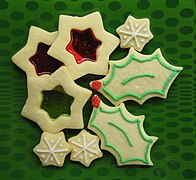 Plain sugar cookies | |
| Type | Cookie |
|---|---|
| Place of origin | United States |
| Main ingredients | Flour, butter, sugar, eggs, vanilla, baking powder, or baking soda |
A sugar cookie, or sugar biscuit, is a cookie with the main ingredients being sugar, flour, butter, eggs, vanilla, and either baking powder or baking soda. [1] Sugar cookies may be formed by hand, dropped, or rolled and cut into shapes. They may be decorated with additional sugar, icing, sprinkles, or a combination of these. Decorative shapes and figures can be cut into the rolled-out dough using a cookie cutter.




